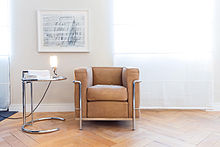
Charles-Édouard Jeanneret, known as Le Corbusier, was a Swiss-French architect, designer, painter, urban planner and writer, who was one of the pioneers of what is now regarded as modern architecture. He was born in Switzerland to French speaking Swiss parents, and acquired French nationality by naturalization on 19 September 1930. His career spanned five decades, in which he designed buildings in Europe, Japan, India, as well as North and South America. He considered that "the roots of modern architecture are to be found in Viollet-le-Duc".
Haworth Inc. is a privately held, family-owned office furniture manufacturer headquartered in Holland, Michigan, United States. Founded in 1948 by G. W. Haworth, the company designs and manufactures seating, tables, movable walls, panels, storage, and wood casegoods. Haworth's furniture pieces, combined with interior design and technology, are intended to create a focus on "organic workspaces that help people perform their best." Haworth employs 7,500 workers and has 650 dealerships in more than 120 countries. 2021 global sales reached $1.96 billion, a 6.2-percent increase from 2020.

Mario Bellini is an Italian architect and designer. After graduating from the Polytechnic University of Milan in 1959, Bellini pursued a career as an architect, exhibition designer, product designer, and furniture designer during the Italian economic boom of the late 20th century. Bellini has received several accolades in a variety of design fields, including eight Compasso d'Oro awards and the Gold Medal for Lifetime Achievement by the Triennale di Milano. In 2019, the Italian President of the Chamber of Deputies, Roberto Fico, awarded Bellini a career medal in recognition of his contributions to Italian architecture and design.
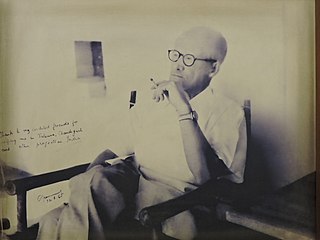
Pierre Jeanneret was a Swiss architect who collaborated with his cousin, Charles-Édouard Jeanneret, for about twenty years.

Charlotte Perriand was a French architect and designer. Her work aimed to create functional living spaces in the belief that better design helps in creating a better society. In her article "L'Art de Vivre" from 1981 she states "The extension of the art of dwelling is the art of living — living in harmony with man's deepest drives and with his adopted or fabricated environment." Charlotte liked to take her time in a space before starting the design process. In Perriand's Autobiography, "Charlotte Perriand: A Life of Creation", she states: "I like being alone when I visit a country or historic site. I like being bathed in its atmosphere, feeling in direct contact with the place without the intrusion of a third party." Her approach to design includes taking in the site and appreciating it for what it is. Perriand felt she connected with any site she was working with or just visiting she enjoyed the living things and would reminisce on a site that was presumed dead.
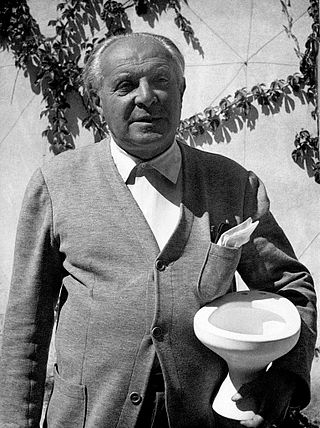
Giovanni "Gio" Ponti was an Italian architect, industrial designer, furniture designer, artist, teacher, writer and publisher.

Modern furniture refers to furniture produced from the late 19th century through the present that is influenced by modernism. Post-World War II ideals of cutting excess, commodification, and practicality of materials in design heavily influenced the aesthetic of the furniture. It was a tremendous departure from all furniture design that had gone before it. There was an opposition to the decorative arts, which included Art Nouveau, Neoclassical, and Victorian styles. Dark or gilded carved wood and richly patterned fabrics gave way to the glittering simplicity and geometry of polished metal. The forms of furniture evolved from visually heavy to visually light. This shift from decorative to minimalist principles of design can be attributed to the introduction of new technology, changes in philosophy, and the influences of the principles of architecture. As Philip Johnson, the founder of the Department of Architecture and Design at the Museum of Modern Art articulates:
"Today industrial design is functionally motivated and follows the same principles as modern architecture: machine-like simplicity, smoothness of surface, avoidance of ornament ... It is perhaps the most fundamental contrast between the two periods of design that in 1900 the Decorative Arts possessed ..."
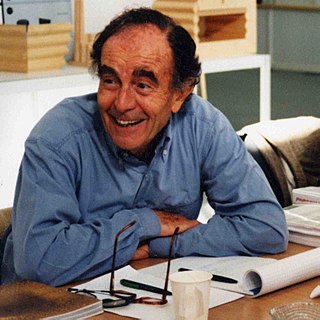
Vico Magistretti was an Italian architect who was also active as an industrial designer, furniture designer, and academic. As a collaborator of humanist architect Ernesto Nathan Rogers, one of Magistretti's first projects was the "poetic" round church in the experimental Milan neighbourhood of QT8. He later designed mass-produced appliances, lighting, and furniture for companies such as Cassina S.p.A., Artemide, and Oluce. These designs won several awards, including the Compasso d'Oro and the Minerva Medal of the Chartered Society of Industrial Artists & Designers in 1986.

Franco Albini was an Italian Neo-Rationalist architect, designer and university instructor in design.

Jean-Marie Massaud is a French architect, inventor and designer. He was born in Toulouse, France in 1966.
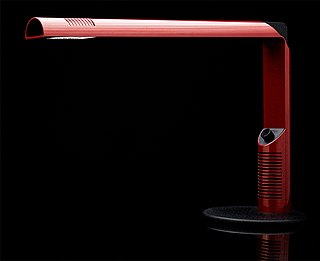
Gianfranco Frattini was an Italian architect and designer. He is a member of the generation that created the Italian design movement in the late 1950s through the 1960s and is considered to have played a major role in shaping it.

Grand Confort is a cube-shaped high armchair, whose leather cushions are held in a chrome-plated steel corset. It was designed as a modernist response to the traditional club chair in 1928 by a team of three: Charlotte Perriand, Le Corbusier, and his cousin and colleague Pierre Jeanneret. The LC-2 and LC-3 were referred as Cusion Baskets by Le Corbusier. They are more colloquially referred to as the petit confort and grand confort due to their respective sizes.
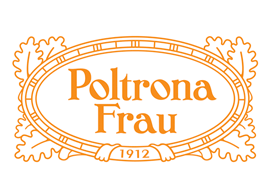
Poltrona Frau is a furniture-maker founded in 1912 by Sardinian-born Renzo Frau in Turin, Italy, headquartered since the early 1960s in Tolentino and specializing in leather seating for interior and automotive applications. The company name combines poltrona, the Italian word for 'armchair', and Frau, the last name of its founder.
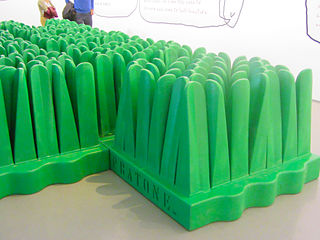
Gufram is an Italian furniture manufacturer known for avant-garde, conceptual, witty, and Pop-art influenced designs; the unconventional use of industrial materials; collaborations with well known architects and designers; and the contribution its products made to the aesthetics of the 1960s Radical period of Italian design.
Le Corbusier's Furniture is a classic furniture line created by Le Corbusier. The line was introduced in 1928 at the Salon d‘Autumne in Paris.

Chaise longue à réglage continu, also Chaise longue modèle B 306 à réglage continu or Chaise longue B 306, is a chaise longue designed by Le Corbusier, Pierre Jeanneret, and the French designer Charlotte Perriand, who worked in the atelier of the Swiss-French architect Le Corbusier and his partner Pierre Jeanneret.

Furniture created in the Art Nouveau style was prominent from the beginning of the 1890s to the beginning of the First World War in 1914. It characteristically used forms based on nature, such as vines, flowers and water lilies, and featured curving and undulating lines, sometimes known as the whiplash line, both in the form and the decoration. Other common characteristics were asymmetry and polychromy, achieved by inlaying different colored woods.

Robby Cantarutti is an Italian architect and industrial designer from Venice and the best known practitioner of Italian Rationalism.

Zanotta is an Italian furniture company particularly known for the iconic pieces of Italian design it produced in the 1960s, 70s, and 80s. These include the "Sacco" bean bag chair and "Blow", the first mass-produced inflatable chair. The company was founded in 1954 and has its main plant in Nova Milanese. In 1984 Zanotta established its experimental division, Zabro, headed by Alessandro Guerriero, with Alessandro Mendini and Stefano Casciani. Since the death of its founder, Aurelio Zanotta, in 1991, it has been run by members of his family. Zanotta's products were awarded the Compasso d'Oro in 1967, 1979, 1987 and 2020.


![Model 683 chair designed by Carlo De Carli [it] was awarded the 1954 Compasso d'Oro Sedia Compasso d'Oro, 1954. Design Carlo De Carli, produzione Cassina.jpg](http://upload.wikimedia.org/wikipedia/commons/thumb/1/15/Sedia_Compasso_d%E2%80%99Oro%2C_1954._Design_Carlo_De_Carli%2C_produzione_Cassina.jpg/220px-Sedia_Compasso_d%E2%80%99Oro%2C_1954._Design_Carlo_De_Carli%2C_produzione_Cassina.jpg)
